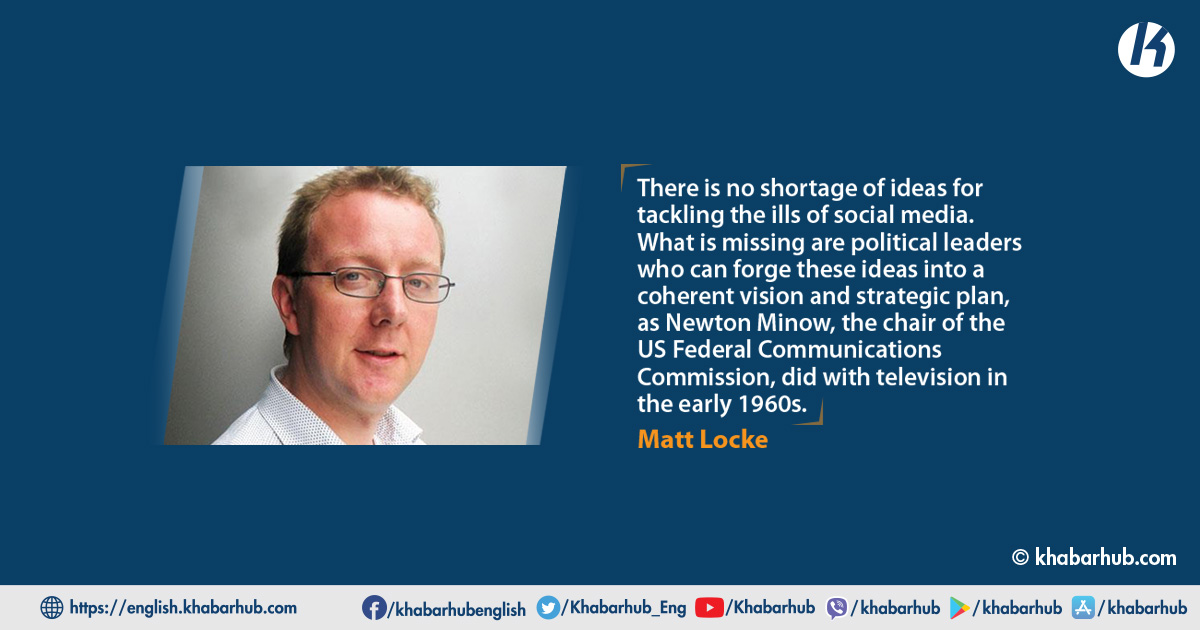On May 9, 1961, then-Chair of the US Federal Communications Commission (FCC) Newton Minow delivered a transformative speech to the National Association of Broadcasters in Washington, DC.
Now known as the “Vast Wasteland” speech, it offered a public-minded vision for a fledgling sector – television broadcasting – that was quickly reshaping society. A similar vision should be applied to social-media platforms today.
In 1961, TV had entered its teenage years. American families had adopted the new technology in record numbers. Regular network broadcasts had begun only 14 years earlier, in 1947, when there were 44,000 TV sets in US homes, around 30,000 of them in New York City.
By 1960, there were 52 million TV sets in the United States – one in nearly nine out of ten households across the country. Not surprisingly, advertisers were flocking to the medium.
But TV was still immature. It faced accusations of fakery, for example, following a series of revelations in the 1950s that quiz shows were rigged.
And, despite countless debates on the subject, the new technology had yet to be harnessed to serve the public interest by providing sustainable spaces for news and education.
Addressing these challenges required not only a vision for change, but also someone in a position of real power to push it. Minow was that person.
There is no shortage of ideas for tackling the ills of social media. For example, recent research published by the New Public Festival describes 14 principles for building better digital public spaces.
In his speech, Minow challenged his audience to spend a day watching the shows they were creating.
They would, he lamented, find a “procession of game shows, formula comedies about totally unbelievable families, blood and thunder, mayhem, violence, sadism, murder, western bad men, western good men, private eyes, gangsters, more violence, and cartoons.
And endlessly, commercials – many screaming, cajoling, and offending.” In 73 hours of primetime viewing per week, Minow noted, 59 during the next season would be dedicated to sitcoms, quiz shows, action dramas, or movies.
To tap TV’s public-interest potential, Minow set out six principles that would guide his FCC chairmanship. The first was that the public – not the broadcasters – owned the airwaves, so it was the broadcasters’ duty to provide a public service.
Minow then offered broadcasters reassurance. He would not drag out any further investigations like those relating to the rigged quiz shows (the second principle). And he believed in free enterprise (the third).
Like TV in 1961, social-media platforms today are entering their teenage years: they have some history – including challenges, mistakes, and squandered opportunities – but they lack maturity.
“I want to see broadcasting improved, and I want you to do the job,” Minow said. “I am proud to champion your cause.”
With that, he separated himself from previous ugly battles between the FCC and broadcasters, and forestalled any accusation that he didn’t appreciate the economics of the sector. It was a master class in positioning.
Minow’s fourth principle offered a challenge: “There are still not enough educational stations, and major centers of the country still lack usable educational channels.”
So, he pledged to give a “hand along the way” to educational television, which “has an enormous contribution to make to the future.”
With his fifth principle, Minow again offered reassurance: he was “unalterably” opposed to government censorship. He was not going to dictate anyone’s broadcasting schedule.
Minow concluded by describing what was at stake. “The squandering of our airwaves is no less important than the lavish waste of any precious natural resource,” he said, and vowed to take his job as FCC chair “very seriously.”
At times, broadcasters may believe that he was taking his job too seriously, he said. “Frankly, I don’t care if you do.”
What is missing are political leaders who can forge these ideas into a coherent vision and strategy. With Ajit Pai stepping down after a controversial tenure heading the FCC, that could be about to change.
On that self-assured note, Minow began to identify practical solutions, rounding out his vision for the medium. It was a strong start for a short but consequential tenure at the FCC: in just two years, Minow would transform the “vast wasteland” of TV and lay the groundwork for public media broadcasting in the US.
Minow relied on carrots, not sticks. Instead of imposing fines and implementing regulations, as his predecessors had done, he directed federal funds to public television for the first time.
For example, he supported the Ford Foundation’s National Educational Television network, the precursor to today’s Public Broadcasting Service. Minow-led initiatives paved the way for the creation of the Corporation for Public Broadcasting and the Children’s Television Workshop.
Minow also created space for such projects to grow. He personally intervened to ensure that major cities like New York and Los Angeles reserved broadcasting spectrum for non-commercial, educational channels.
Like TV in 1961, social-media platforms today are entering their teenage years: they have some history – including challenges, mistakes, and squandered opportunities – but they lack maturity.
And the damage they are inflicting on our public and civic spaces may well be more severe than anything TV wrought in 1961.
There is no shortage of ideas for tackling the ills of social media. For example, recent research published by the New Public Festival describes 14 principles for building better digital public spaces.
After a year in which we have come to rely on digital networks for everything from education to vaccination, the next FCC chair must put public value at the heart of US digital strategy.
The Luminate Group is gathering support for an International Fund for Public Interest Media.
And both the Dutch PublicSpaces project and my own Public Media Stack have offered practical tools to help reduce reliance on commercial platforms.
What is missing are political leaders who can forge these ideas into a coherent vision and strategy. With Ajit Pai stepping down after a controversial tenure heading the FCC, that could be about to change.
To ensure that it does, US President Joe Biden must seek a replacement with a clear, practical vision that, like Minow’s, strikes a balance between nurturing a fast-growing adolescent industry and holding it to a new standard of public service.
By nominating strong, independent voices like Lina Khan and Tim Wu to the FCC, Biden has already shown that he will challenge the industry to be more public-minded. Choosing Jessica Rosenworcel, who has championed net neutrality, as acting FCC chair is another good sign.
After a year in which we have come to rely on digital networks for everything from education to vaccination, the next FCC chair must put public value at the heart of US digital strategy.
(Matt Locke, former head of Innovation at BBC New Media and head of Multiplatform at Channel 4, is Director of Storythings and Project Lead at Public Media Stack)
Copyright: Project Syndicate









Comment